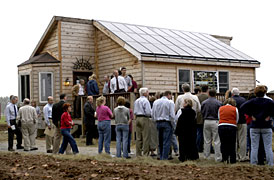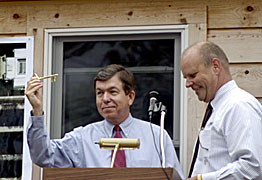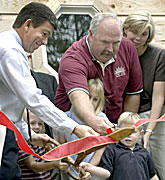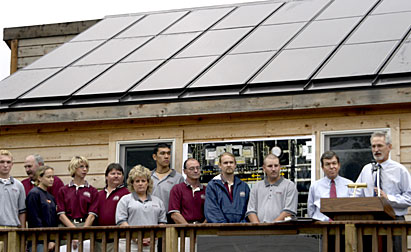
The Crowder College Solar House officially was dedicated at its permanent site on the campus in Neosho last Friday. Assisting with the ceremony was Seventh District Congressman and Majority Whip Roy Blunt.
Positioned within the shadows of the Washington Monument and the U.S. Capitol in Washington, D.C. last fall, the solar house won sixth place out of 14 in the Solar Decathlon, an event where students competed to design, build and operate the most effective and efficient solar-powered house. The contest was organized by the U.S. Dept. of Energys National Renewable Energy Lab and sponsored on the national level by BP Solar, Home Depot, Electrical Data Systems and the American Institute of Architects. It was judged by a panel of 6 architects and design professionals.

Seventh District Congressman and Majority Whip Roy Blunt holds up the key to the Crowder College solar house given to him by Dr. Kent A. Farnsworth, Crowder president, pictured at right. Blunt was told that he could stay whenever he liked but he was limited to the number of houseguests he could bring with him to the 612 square foot house.
Im proud of the leadership, faculty and students who represented the campus so well, Blunt said. And in speaking about the 2-year community college competing at the highest levelwith top technical universities, Blunt added that it stands out pretty dramatically when plopped down in the middle of Washington, D.C.

The Hon. Roy A. Blunt assists Dan and Gina Eberle and their children in a ribbon ceremony officially opening the Crowder solar house. The Eberles provided the seed money of $75,000 needed to initiate the project with the understanding that Crowder would have the opportunity to buy back the house from them. A solar car team member, Dan Eberle has deep roots in the solar program. The family was presented with a copy of the placque hung inside the house in their honor.
The figure for the total cost of constructing the solar home is unknown. An accurate accounting still has not made of all the materials donated. However, 2005 Solar Decathlon rules will mandate including the cost. The Crowder team already is preparing for that event.
Although the top three awards went to the University of Colorado at Boulder, the University of Virginia and Auburn University, Crowder with its cottage-type house won the coveted Peoples Choice Award for design and style. Crowders other recognition was for energy balance, best technical design for lighting, connection under the sun, home office and insulation (green award).

Monty Pugh-Towe, chosen team captain for the U.S. Dept. of Energy's 2005 Solar Decathlon Contest, demonstrates the radiant floor heating and domestic hot water systems installed in the house. The hybrid system uses solar panel arrays on both the south and north facing roofs. The team was surprised to find that the north array produced 50% of the total energy during the summer months, enough to provide excess electricity and hot water for taking a soak in the hot tub that sat on the back deck.
In discussing ways in which the team could improve their performance in the 2005 decathlon, Art Boyt, head faculty advisor, put hiring an advisory architect to perfect the lingo that architects like to hear on top of the list. Without its own architecture program, Crowder had to rely on community support for planning and presentation, gaining the school an award for best use of resources. But, in spite of popular opinion, it scored low in both design presentation and simulation, and design and livability, one of the ten contests which would have garnered twice as many points as the others.
What is solar energy?
Solar thermal technologies use collectors to absorb the suns light energy and change it into heat energy. This thermal energy can then be used to generate heated water or space heating or cooling. Solar electric, or photovoltaic (PV), technologies use semiconductor materials to convert sunlight directly to electricity.
In a shift from fossil fuels to renewable energy, consumers must lead the way. Although it may be highly unlikely that Americans with their intensive energy use will accept present solar energy technology that prohibits unrestrained energy use on cloudy days, those associated with the energy program hope that, if anything, consumers may simply learn to avoid wasting energy and look for ways to make their homes more energy efficient.
Blunt told the audience that he hopes Congress will pass an energy bill to respond to the crisis. Perhaps, out of the bad thing like the August 2003 black-out, there will be a good resulta long term energy policy.
To view the Gallery of Homes, click here.

Members of the Crowder College Solar House Team line up on the porch during a ceremony to officially open the house on campus in Neosho. At the lecturn is Art Boyt, alternative energy instructor/MARET Center director. To his left is The Honorable Roy Blunt, a guest speaker.






Comments